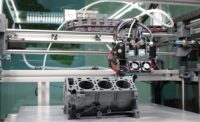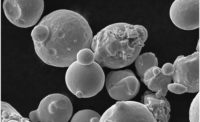On every trade show floor featuring additive manufacturing, there’s a growing selection of additive processes for making production parts that stand alongside machines more commonly associated with prototyping. An essential aspect of additive’s transition from prototyping to production is data collection. Data is transforming the factory floor, and additive can do more than play catchup to traditional machining, it can take a leading position—its digital nature is inherently suited to collect information about the part as it’s built, layer by layer.
In some cases, this means adding sensors inside the build volume, but a new focus on data from additive can also unlock information already recorded by machines, but previously unavailable or unconsidered for retrieval. That information is integral now as productions parts for aerospace and automotive are made additively — process and part certification plays an important role.
“When you are creating a prototype, [data] is not necessarily a need,” says Scott Sevcik, vice president of manufacturing solutions for Stratasys. “A lot of the equipment that exists today, its history is in prototyping. We’re at a stage in the industry now where we have some advanced prototyping equipment that we’re re-purposing into manufacturing. There are gaps that [the additive industry] needs to identify and fill in order to make sure that high-end technology developed for prototyping can be effectively used in manufacturing. So that’s been about driving repeatability.”
The Rise of SPC in Additive
Stratasys’ customers are now making production parts with its technology, and the 3D printer maker is innovating to tie its systems in with legacy manufacturing interfaces. For instance, its new Fortus 900 3D printing system includes MTConnect for Statistical Process Control data collection.
“So for the first time we’ve got advanced additive manufacturing equipment where you can stream data off of that system for use in quality applications,” Sevcik explains. “There is not a lot of technology today that has looked towards implementing the interfaces that exist for machine tools. So that was a really obvious step for us to take. Our customers are using these systems the same way they’re using traditional technologies. So we need to provide the same kind of interface, the same sort of data that’s required from traditional for additive.”
Statistical process control reporting capabilities are still in the early stages of adoption in additive manufacturing, because SPC is most relevant for full-production environments. As additive enters that world, SPC will play a role in ensuring repeatable and consistent parts and processes. Carbon, a Silicon Valley-based maker of industrial 3D printers, offers machines that record specific data, such as the printer on which the part was manufactured, as well as the time, location, and operator. It can also measure process-specific metrics like cycle time and changeover time, according to Chris Van Wert, Carbon vice president of manufacturing and quality.
“Additionally, there is a closed-loop control on the printer that generates SPC-like data to ensure that it’s operating within a required parameter set,” he says. “In upcoming product updates, we’ll also enable more process-specific data such as a closed-loop control on force sensing for resin refill.”
The data collected will—and in some applications, already can—link to Carbon’s quality control database, which will log print-specific and product-specific data in a single location, enabling better process control (including SPC) and problem-solving/root-cause analysis.
“Data can be exported to sync with SPC software as needed on an application-specific basis,” he says. “We generate data at the printer as a part is printing as well as generate data after it’s been printed at the printer. That all gets tied together in our data processing and analysis tool, which allows us to have more continuous data as opposed to data by batch.”
Integrated Machine Vision
Inspection sensors that provide data to software applications and quality engineers are also increasing in importance. At the Oak Ridge National Laboratory, engineers utilize in-situ sensing to capture images at every single stage of a build.
“We will take actual images of the build as its occurring, and from that information we can look at the porosity content of every single layer that’s printed,” explains Ryan Dehoff, deposition science and technology group leader at ORNL. “We can look at any build defects that may or may not be occurring and relate that back to improving the process.
“With the rapid turnaround on the equipment, you can get through multiple iterations so quickly. We use that as a method to fix the build and then start a new build the following day and basically limit the amount of failed parts that we build on a regular basis.
“So we are seeing huge trends in that space, with a lot of value proposition. We’ve actually been doing this for a number of years now, some of the machine vendors have some of this in-process monitoring built into their machines. So we’ve been working at Oak Ridge to do a lot of work on extracting that data, utilizing that data, evaluating and understanding that data, and then basically incorporating it back into the printing process in order to make better components.”
Machine vendors only began adding inspection sensors into the equipment in the last few years, Dehoff says, concurrent with the industry shift from prototyping to the future of additive production parts.
Unlocking Existing Data
The new focus on quality and data within additive “changes everything,” Dehoff says, as manufacturers productionize the tech. “All the nuances about the printing process, the resulting micro-structure properties, defect structure, all of that is incredibly important now. And I think what we’re finding is this understanding about the printing process has increased exponentially just because we now have data and eyes and understanding about what the tech is actually doing.”
Dehoff likes to mention the advent of CNC machines as a potent comparison to the current data evolution in additive. “There was a point in time when we didn’t have CNC controlled equipment,” he says. “Everything was milled by hand. To me, the data portion of additive is that fundamental difference between everything made by hand, an artisan type of thing, to a real revolution where you can actually use 3D printing in really high-end environments. In addition to vision sensors and other in-situ inspection, the additive machines themselves generate usable data for quality control purposes.”
In many cases, manufacturers didn’t actually know all of the data that was being collected on the machine, Dehoff says.
“So something as simple as looking at the current value on a motor—you apply current to move the rake back and forth or the extrude head—the amount of force exerted on that motor during that process can be collected, sent back and it gives you information about how the process is running,” he adds. “So there are some pieces of equipment that collected all this data, but people didn’t know it. So people didn’t know how to use it, or know that we should be looking for it. Recently, people have started to delve into some of that and understand the value of what was actually being collected. And once they started doing that, I think they found out that a lot of good can be achieved.”







